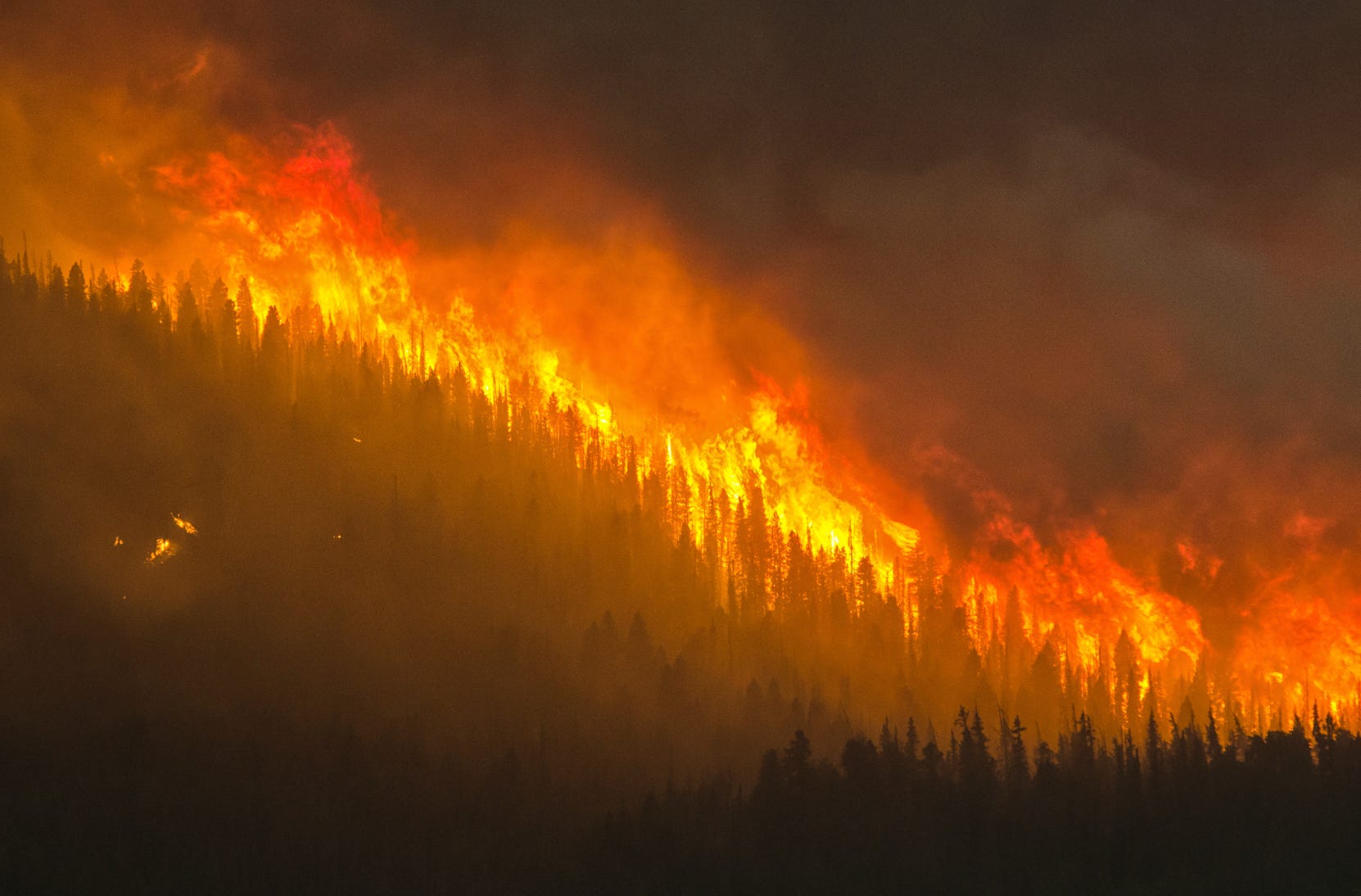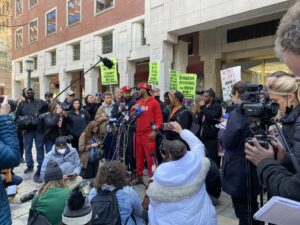Thousands of federal wildland firefighters who are tackling increasingly deadly catastrophic wildfires all over the U.S. — such as the recent series of fires in Hawaii, where at least 110 people were killed — are now also facing the prospect of an enormous pay cut at the end of September.
The union representing the approximately 15,000 federal wildland firefighters says that if the cut is allowed to happen, it’ll exacerbate an ongoing mass exodus of wildland firefighters out of the federal workforce over the last several years, often to better jobs at state and municipal fire agencies.
“There’s so many fire engines just sitting and collecting dust this summer,” Steve Gutierrez, a 15-year former federal firefighter for the U.S. Forest Service who left this year to become an organizer and national business representative for the National Federation of Federal Employees, told More Perfect Union. “There’s no one to staff them.”
Federal wildland firefighters, who work under the U.S. Forest Service and several Interior Department agencies, were making a starting wage of just $13 per hour on average when President Joe Biden took office in 2021. The Biden administration implemented a $15 minimum wage for firefighters in August 2021, and the 2021 infrastructure law passed by Congress temporarily boosted the salary made by federal firefighters by either 50 percent or $20,000, whichever was lower.
That increase was set to last for two years, through September 2023, while the Biden administration “worked with Congress on longer-term reforms,” according to a June 2022 White House press release. Those reforms, some of which were proposed in Biden’s FY2024 budget, were supposed to include permanent pay increases and a revamping of the federal classification system—but Congress has not passed anything, leading to the pay cliff facing firefighters at the end of September.
And Casey Judd, the business manager for the Federal Wildland Fire Services Association advocacy group and a former federal firefighter, worries that the longer the impasse drags out, the more likely it’ll be that Congress and the public forget about them.
“We’re hoping…that the focus won’t go away when the snow starts to fall in the east,” Judd told More Perfect Union. “There’s plenty of money. Don’t let Congress fool us and tell us, ‘Oh gosh, we don’t have money.'”
Competing legislation
There are several bills in Congress right now that would ostensibly avoid the pay cliff, and implement new pay grades to go along with the new firefighter classifications.
One bill, introduced by GOP Rep. Doug LaMalfa of California, would pull unspent funds from the Inflation Reduction Act for another two-year funding bridge until a more permanent solution is reached. Judd said that Lamalfa has been a longtime ally to wildland firefighters, and he chairs a key House Agriculture subcommittee.
But Gutierrez says the NFFE, the union representing thousands of federal firefighters in the Forest Service and Department of the Interior, isn’t supporting the Republican bill because it sunsets in two years and also contains forestry management provisions that would make it harder to get through the House.
“The two-year sunset puts us in this same position that these hardworking men and women are at right now,” he said. “How would you like to know, ‘I don’t know if I’m going to buy a house because I might lose 50 percent of my pay in two years.'”
A bill in the Senate, sponsored by Arizona Sen. Kyrsten Sinema and backed by a bipartisan coalition, would make the pay raises permanent, including a special pay rate for federal firefighters as well as supplemental pay every day they’re on wildfire deployments, according to Government Executive. The bill, which was endorsed by NFFE, easily passed a Senate committee vote in July.
Yet a third bill, which would provide more comprehensive reforms, is being pushed by a bipartisan group led by Democrats Rep. Joe Neguse and Sen. Michael Bennet, both of Colorado. The bill, known as “Tim’s Act” after a federal smokejumper who died in 2021 while battling a fire in New Mexico, would boost starting pay to $20 an hour, provide paid rest and recuperation after fighting wildfires, and include a housing stipend, tuition assistance and more. That bill, however, has not yet come up for a vote in either the House or Senate.
For Judd, the focus is on getting something passed before attention turns elsewhere.
‘”During the fire season, Congress perks up. I get a lot of questions of: ‘’What can I do?’” he told More Perfect Union. “And I politely tell them, ‘We’ve been telling you for 20 years.'”
A ‘staggering’ federal firefighter brain drain
Even before the pay cliff, firefighters have been fleeing the federal government for years for a multitude of reasons, advocates say. A central complaint is the issue of pay, which pales in comparison to state counterparts like CAL FIRE.
A mid-career federal firefighter makes just half what a third-year California state firefighter does, and retired CAL Fire pensioners can make nearly five times as much as a federal firefighter in salary and pension over the course of a 30-year career, according to the advocacy group Grassroots Wildland Firefighters.
CAL Fire has become an attractive destination for disgruntled firefighters—and there are a lot of disgruntled firefighters. Over the course of one 48-hour period in May, 42 U.S. Forest Service firefighters working out of San Bernardino National Forest in California resigned, according to a July NBC News report.
The Forest Service employed roughly 12,800 wildland firefighters in 2021, according to a 2022 Government Accountability Office report on recruitment and retention issues in the federal fire service; as of July 25, the Forest Service said it was at 99 percent of its goal of hiring 11,300 firefighters, a 12 percent decrease.
The Department of the Interior — which employs firefighters for the National Park Service, Bureau of Indian Affairs, Bureau of Land Management, and U.S. Fish and Wildlife Service — employed 4,923 wildland fire personnel as of August 8, with a goal of hiring 5,800 federal and 900 Tribal firefighters by the end of 2023.
(In addition to federal wildland firefighters, there are approximately 7,500 firefighters who work for the Defense Department.)
“With climate change fueling more severe wildfires and extending fire seasons into fire years, hiring and retaining the federal wildland firefighters needed to combat this growing challenge is more important than ever,” the Forest Service said in a statement to More Perfect Union. “For decades, federal wildland firefighters have faced these challenges while their pay has lagged behind their state, local and private counterparts in some areas of the U.S.”
It’s not just poor pay, either. The GAO report cited career advancement, mental health, limited diversity, and poor work-life balance — federal wildland firefighters can work more than 16 hours a day while responding to fires, and are often away from home for months — and other issues undermining retention.
Many federal wildland firefighters currently aren’t even classified as federal firefighters, but rather as technicians under a system that hadn’t been updated since 1972. The Office of Personnel Management finally approved an update to the classification system last year, but the Forest Service requested and received an extension to December 2023 to implement the “complex” new changes.
“The agencies call them ‘forestry technicians and range technicians’. They’re wildland firefighters,” Judd said.
“People go to CAL FIRE simply because the CAL FIRE firefighter badges say ‘firefighter,” he said, before adding: “And of course they get paid a whole lot more.”
Adding to the problems is an inadequate housing situation. Gutierrez told More Perfect Union that when he was in the Forest Service, he would have to work 1,000 hours of overtime and take on a second job to make ends meet, even as a renter with no children.
“Housing is such a huge issue for firefighters that are in rural communities because they’re also tourist towns” like Lake Tahoe, he said. “They’re paying Lake Tahoe rates at $15 an hour, and they can’t afford it. There’s several wildland firefighters out there that live out of their cars because they can’t afford rent where they work.”
Taken together, the problems add up to a fundamental mistreatment of workers in some of the most dangerous and important emergency response positions in the federal government.
“Why can’t we just take care of our folks? Gutierrez asked. “No one’s trying to be a millionaire. We just want to pay the bills and have a good living.”
Additional reporting by Nicole Bardasz.



